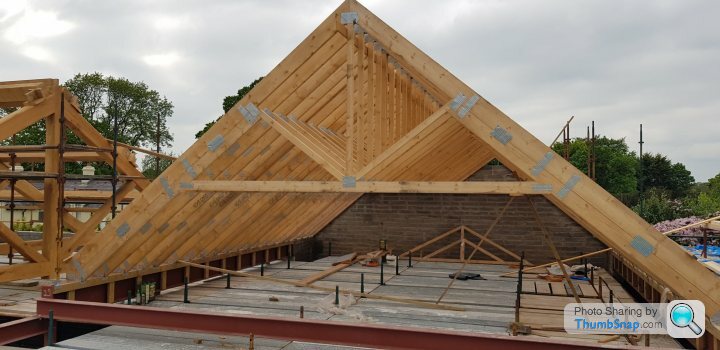Can I remove this roof truss? Pics
Discussion
Grumbly said:
There is very little bending in the members until the truss is cut. Once cut there are bending and shear loads in all the members, the critical point will be, as you have correctly pointed out, the short section of rafter between the wall plate and the ceiling tie.
This short section of rafter now effectively acts as a cantilever with half of the dead and live load supported by the truss acting as a point load at the tip.
Is there a way to beef up the foot or so of rafter that is now "exposed". Can I sandwich more wood around it to thicken up the bottom bit?This short section of rafter now effectively acts as a cantilever with half of the dead and live load supported by the truss acting as a point load at the tip.
Toltec said:
A quick search for raised tie roof truss found this picture
https://murdockrooftrusses.com/wp-content/uploads/...

Note the way the lower section of the rafter is expanded with another section of timber.
Also note what it's bearing onto...https://murdockrooftrusses.com/wp-content/uploads/...

Note the way the lower section of the rafter is expanded with another section of timber.
Toltec said:
A quick search for raised tie roof truss found this picture
https://murdockrooftrusses.com/wp-content/uploads/...

Note the way the lower section of the rafter is expanded with another section of timber.
Ah great minds think alike, yes, that's what I mean, beefing up the lowest bit, should be straightforward?https://murdockrooftrusses.com/wp-content/uploads/...

Note the way the lower section of the rafter is expanded with another section of timber.
Beyond Rational said:
Toltec said:
A quick search for raised tie roof truss found this picture
https://murdockrooftrusses.com/wp-content/uploads/...

Note the way the lower section of the rafter is expanded with another section of timber.
Also note what it's bearing onto...https://murdockrooftrusses.com/wp-content/uploads/...

Note the way the lower section of the rafter is expanded with another section of timber.
Beyond Rational said:
Largechris said:
smokey mow said:
Largechris said:
I've read that I should be able to raise the span by 1/3 of the height with no issues? The current wood all looks like 4"x2".
That guidance is for a cut roof and not trusses.For a 5m span on a cut roof the rafters would need to be a minimum of 50x175 so yours are woefully undersized.
As already said, you need a structural engineer
I can do the structural calculations myself I'm a qualified engineer. Just looks like this is the quick way to move one rafter a tiny bit upwards?
Largechris said:
Is there a way to beef up the foot or so of rafter that is now "exposed". Can I sandwich more wood around it to thicken up the bottom bit?
Yes, look at the picture helpfully posted above, the lower rafter of the truss has extra depth added, This would be difficult in situ so will need to bolt additional timber to the side.Largechris said:
I have a detached garage with quite a steep pitched roof <clip>
The ends of the trusses look like this, so I think they just rest on the top of the walls:
 [url]
[url]
The wood bits are currently held together with these perforated metal plate things:
 |https://thumbsnap.com/hkceiJ2Z[/url]
|https://thumbsnap.com/hkceiJ2Z[/url]
On a lighter note, have you photographed that through a broken car windscreen or is the lens on your phone so badly cracked that it shows up on your images! The ends of the trusses look like this, so I think they just rest on the top of the walls:
 [url]
[url]The wood bits are currently held together with these perforated metal plate things:
 |https://thumbsnap.com/hkceiJ2Z[/url]
|https://thumbsnap.com/hkceiJ2Z[/url]
Grumbly said:
Largechris said:
Is there a way to beef up the foot or so of rafter that is now "exposed". Can I sandwich more wood around it to thicken up the bottom bit?
Yes, look at the picture helpfully posted above, the lower rafter of the truss has extra depth added, This would be difficult in situ so will need to bolt additional timber to the side.RichB said:
Largechris said:
I have a detached garage with quite a steep pitched roof <clip>
The ends of the trusses look like this, so I think they just rest on the top of the walls:
 [url]
[url]
The wood bits are currently held together with these perforated metal plate things:
 |https://thumbsnap.com/hkceiJ2Z[/url]
|https://thumbsnap.com/hkceiJ2Z[/url]
On a lighter note, have you photographed that through a broken car windscreen or is the lens on your phone so badly cracked that it shows up on your images! The ends of the trusses look like this, so I think they just rest on the top of the walls:
 [url]
[url]The wood bits are currently held together with these perforated metal plate things:
 |https://thumbsnap.com/hkceiJ2Z[/url]
|https://thumbsnap.com/hkceiJ2Z[/url]
Largechris said:
Grumbly said:
Largechris said:
Is there a way to beef up the foot or so of rafter that is now "exposed". Can I sandwich more wood around it to thicken up the bottom bit?
Yes, look at the picture helpfully posted above, the lower rafter of the truss has extra depth added, This would be difficult in situ so will need to bolt additional timber to the side.Grumbly said:
Largechris said:
Grumbly said:
Largechris said:
Is there a way to beef up the foot or so of rafter that is now "exposed". Can I sandwich more wood around it to thicken up the bottom bit?
Yes, look at the picture helpfully posted above, the lower rafter of the truss has extra depth added, This would be difficult in situ so will need to bolt additional timber to the side.On a more serious note; are you wanting to do this to make room for a 4 post lift? Reason I ask is that my garage roof is exactly the same; steep pitch, 5m depth and three bays long. I would love to put a 4 post lift in the centre bay but to get the headroom it would require raising some of the rafter ties/joists in the central area. This thread is of interest.
RichB said:
On a more serious note; are you wanting to do this to make room for a 4 post lift? Reason I ask is that my garage roof is exactly the same; steep pitch, 5m depth and three bays long. I would love to put a 4 post lift in the centre bay but to get the headroom it would require raising some of the rafter ties/joists in the central area. This thread is of interest.
Yes and no. I know it's a popular request with the four post lifts to do the same thing with the trusses, I'm only looking to move one of four trusses to make more headroom for one of my special interest hobbies.I think from having seen similar threads, if you want to do all the garage trusses, you'll be advised to take the roof off and start again.
Grumbly said:
Please bear in mind that this work would be subject to building regulation approval, and whilst problems are unlikely doing the work, it will come to light when you come to sell if you don't get the approval required.
Cheers, does this apply to a detached garage? I'm wondering for such a small job if it wouldn't be easier to restore the original truss if I do ever sell?Largechris said:
Yes and no. I know it's a popular request with the four post lifts to do the same thing with the trusses, I'm only looking to move one of four trusses to make more headroom for one of my special interest hobbies.
I think from having seen similar threads, if you want to do all the garage trusses, you'll be advised to take the roof off and start again.
Giraffe porn?I think from having seen similar threads, if you want to do all the garage trusses, you'll be advised to take the roof off and start again.
Largechris said:
Grumbly said:
Please bear in mind that this work would be subject to building regulation approval, and whilst problems are unlikely doing the work, it will come to light when you come to sell if you don't get the approval required.
Cheers, does this apply to a detached garage? I'm wondering for such a small job if it wouldn't be easier to restore the original truss if I do ever sell?Largechris said:
smokey mow said:
Largechris said:
I've read that I should be able to raise the span by 1/3 of the height with no issues? The current wood all looks like 4"x2".
That guidance is for a cut roof and not trusses.For a 5m span on a cut roof the rafters would need to be a minimum of 50x175 so yours are woefully undersized.
As already said, you need a structural engineer
I can do the structural calculations myself I'm a qualified engineer. Just looks like this is the quick way to move one rafter a tiny bit upwards?
Don’t guess. Get paid advice and calculations from someone that knows what they’re doing.
Absolutely will need structural calcs and BR approval. The issue with trussed rafters is load is carried by the bottom chord, which bears directly of the wall plate (laterally bracing the walls) with the rafter section tied in via the ‘gang nail’ plate. You are doing away with the bottom chord, thereby introducing load in other ways (particularly a ‘spread’ load on the wall tops). Don’t try to ‘amateur engineer’ this, it needs doing properly.
darren f said:
Absolutely will need structural calcs and BR approval. The issue with trussed rafters is load is carried by the bottom chord, which bears directly of the wall plate (laterally bracing the walls) with the rafter section tied in via the ‘gang nail’ plate. You are doing away with the bottom chord, thereby introducing load in other ways (particularly a ‘spread’ load on the wall tops). Don’t try to ‘amateur engineer’ this, it needs doing properly.
I'm with you here; there are so many ways that you can get 'caught out' for example most structural timber is c16 but roof trusses are often c27. If that bottom cord bends then it will introduce a lateral force on the wall which is usually either bad or very bad.Trusses are very cheap. It may be easier and cheaper to put a new truss designed with the higher bottom chord/boom either side of the existing one.
Gassing Station | Homes, Gardens and DIY | Top of Page | What's New | My Stuff



